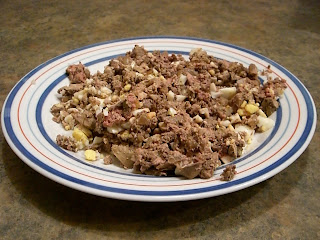
What does it mean to keep Kosher? This is a question that many non-Jews, and Jews alike, are still grappling with the answer to. Is kosher a type of food? Is it a blessing? Is it a way of life?
What makes someone, or something, kosher?
This blog post will give a basic overview of what it means to keep kosher, what kosher laws are, and what those laws translate to for practical use.
Kosher, or “Kashrut,” refers to Jewish dietary laws that have been a part of Jewish culture since the creation of the Torah. Today, many Jewish people continue to keep kosher, while others don’t. Different individuals and groups interpret the importance of keeping kosher differently. (Brewer 2009)
You are not required to be Jewish to abide by the specific kosher laws (Carter isn’t Jewish and we practiced kosher cooking for this blog), but it is traditionally only the Jewish people who maintain these dietary rules.
The following are the kosher dietary laws, according to Tracey Rich’s “Kashrut: Jewish Dietary Laws”:
People can only eat land mammals if they have cloven hooves and chew their cud. If it doesn’t do both of these things, then the animal is forbidden.
Not kosher: The camel, the rock badger, the hare, and the pig. These animals aren't kosher because each lacks one of the aforementioned qualities.
Kosher: Cattle, sheep, goats, deer, and bison.
Of water animals, anything that has both fins and scales is considered kosher.
Not kosher: Shellfish, such as lobster, oysters, shrimps, clams, and crab.
Kosher: Fish like tuna, carp, salmon, and heron.
The bird category is less clear. The Torah provides a list of the following forbidden birds but omits a description of why they are forbidden.
Not kosher: Bat, cuckoo, eagle, hawk, heron, kite, lapwing, ostrich, owl, pelican, stork, swan, and vulture.
Kosher: Capon, chicken, dove, duck, goose, pigeon, and turkey.
Any product derived from these forbidden animals such as their milk, eggs, fat, or organs is also forbidden by kosher laws. For example, rennet, an enzyme used to harden cheese, is usually obtained from non-kosher animals. This makes kosher cheese difficult to find. (Luban, p.1)
There are many specific kosher rules in regards to animal slaughtering. Kosher ritual slaughter, known as shechitah, is a method of slaughter that uses a quick, deep stroke across the throat of the animal with a perfectly sharp blade that has no nicks or unevenness. (Rich 2007) The idea behind this method is that it causes a painless death that results in unconsciousness in two seconds. The method is widely recognized as the most humane of slaughtering methods. All blood must be drained from meat and poultry or broiled out of it before it is eaten. (Glazer, p.317)
Separation of meat and dairy is another important aspect of keeping kosher. Meat (the flesh of birds and mammals) cannot be eaten alongside or combined with dairy. Meat must be cooked separately from dairy products, as well as served on separate dishes with separate utensils, during a separate meal. People are advised to wait 3-6 hours after eating meat before they eat dairy. However, people are allowed to consume meat soon after consuming diary, if they wash out their mouths. (Glazer, p.318) These meat and dairy restrictions are the law because the Torah tells us “not to boil a kid in its mother’s milk” on three separate occasions. Fish, eggs, fruits, vegetables and grains can be eaten with either meat or dairy. (Rich 2007)
Rabbis or other “religious figures do not bless food to make it kosher. Blessings are made over food before eating it, but these blessings have nothing to do with making the food kosher.” (Rich 2007) Many types of foods can be kosher if they are prepared according to the aforementioned dietary laws.
The Torah does not tell Jewish people exactly why they should obey these dietary laws. Some have even “suggested that the laws of kashrut fall into the category of "chukkim," laws for which there is no reason.” (Rich 2007) No one really knows for sure why kosher laws were originally created, but there have been various interpretations as to why these laws are important and how they should be followed today. (Brewer 2009)
For this blog, we have cooked 10 different kosher recipes (Nathan, p.48-390), showing how Jews living in America have adjusted traditional recipes to make them their own.
As Isaac Arbabanel said, centuries ago, “the laws of kashrut did not come to heal bodies, but to seek the health of the soul.” (Glazer, p.317)
If you’d like to learn more about keeping kosher and kosher laws, please refer to this link.
-Carter & Sarah
Brewer, Aaron. "Judaism." Jewish Recipes: Living Kosher is like Living like a Jew. N.p., Oct. 2009. Web. 6 Mar. 2010.
Glazer, Phyllis, and Miriyam Glazer. Jewish Festival Cooking. New York, NY: HarperCollins Publishers Inc., 2004. Print.
Luban, Yaakov. "The Kosher Primer." OUKosher. N.p. .n.d. Web. 14 Feb. 2010.
Nathan, Joan. Jewish Cooking in America. New York, NY: Alfred A. Knopf, Inc., 1994.
Print.
Rich, Tracey. "Kashrut: Jewish Dietary Laws." Judaism 101. N.p., 2007. Web. 6 Mar. 2010.

















